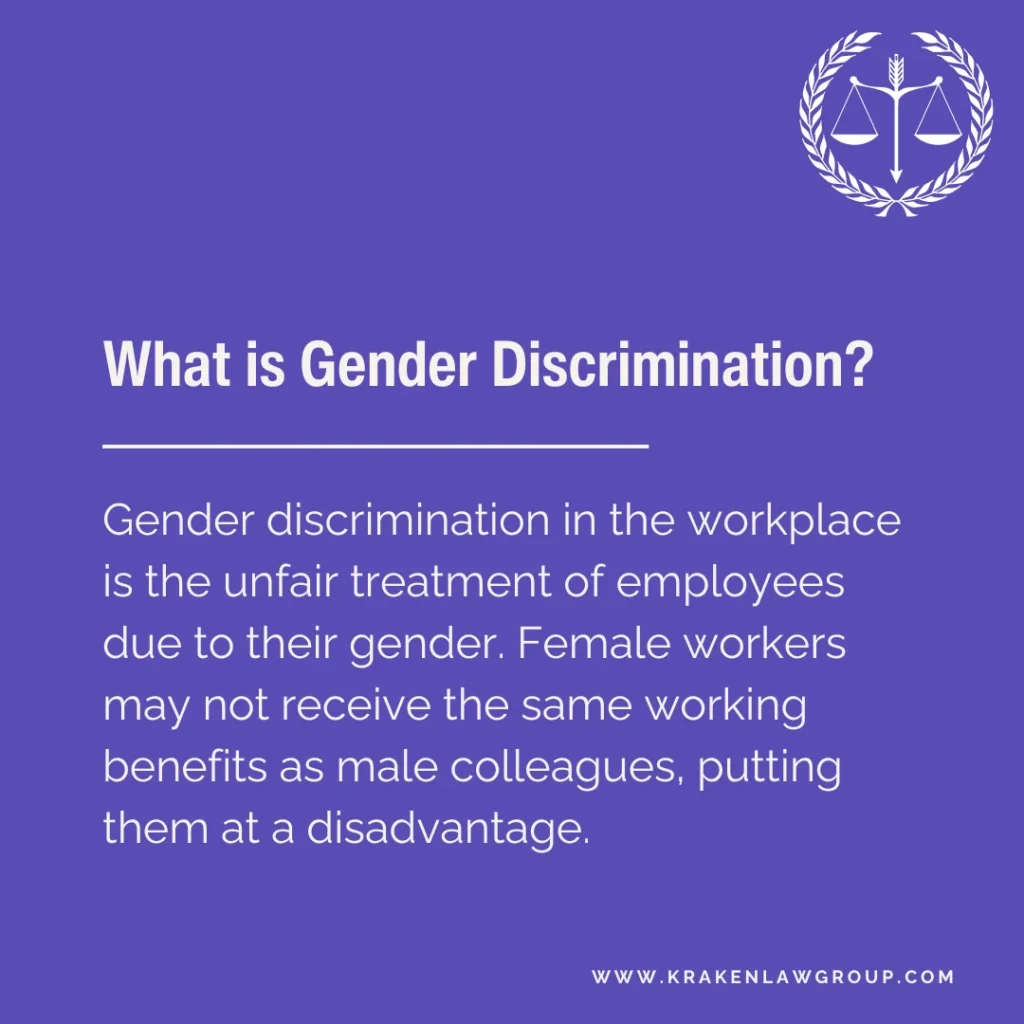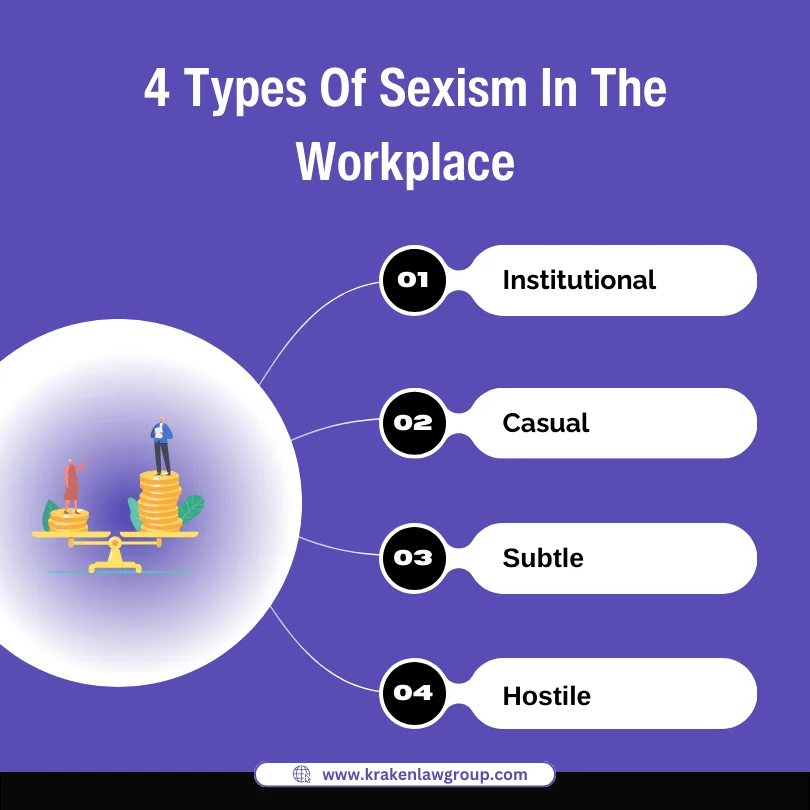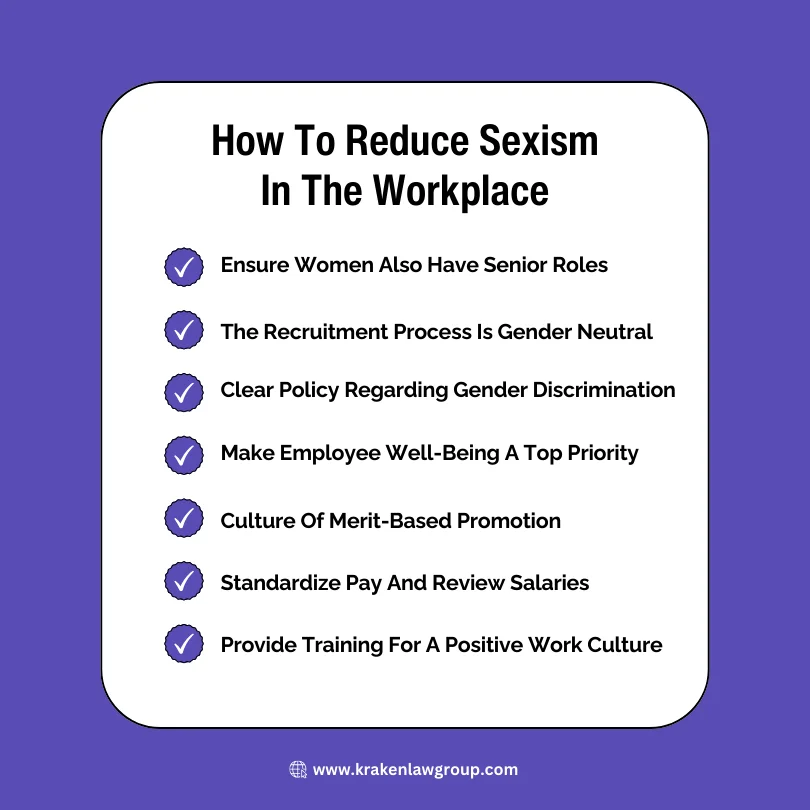A common perception famous in many industries is that all men and women have different skills. Some also believe that the talents of male employees are better than those of female workers.
Such prejudices lead to the concentration of sexism in many professional fields. The good news is that you don’t have to for change to come in the industry.
Instead, you can initiate policies that can eliminate sexism in the workplace and encourage other businesses to do the same. So let’s look at everything you must know about it.
Gender Discrimination Meaning Explained

Gender discrimination in the workplace is the unfair treatment of employees due to their gender. Female workers may not receive the same working benefits as male colleagues, putting them at a disadvantage.
About 4 out of 10 working women in the US state that they face gender discrimination. Many of these females also earned less than their male colleagues.
A few examples of gender bias in the workplace include:
- Not being hired after an interview
- Harsh performance evaluation than other employees
- Lower salary
- Denial of promotions
- Lack of training
- Insulting remarks
- Susceptibility to sexual harassment
Remember gender bias is illegal in the US and any company engaging in it can be held liable. So you must always take action against such injustices.
The Impact Of Gender Discrimination In The Workplace

The impact of gender discrimination in the workplace has been severe and leading to disparity in industries. Female and queer employees are being shut out of different roles despite their high qualifications.
It also affects the performance and psyche of workers negatively. Lower salaries despite high qualifications lead to mental health changes. Depression may be common in workers who suffer from sexism in the workplace.
Workers also experience low job satisfaction and many have left their jobs due to such injustices. This has been leading to a shortage of employees in specific industries.
So it has become more important than ever to reduce sexism in the workplace. Otherwise, the waste of resources can lead to drastic changes in the economy.
4 Types Of Sexism In The Workplace

Sexism in the workplace can be classified into four categories to help people grasp it easily:
Institutional Sexism
Institutional sexism occurs when an institute involves itself in sexist principles. Examples of an institute include:
- Law enforcement agencies
- Healthcare institutes
- Media companies
- Schools, colleges, and universities
- Banks
Such companies may implement sexist policies and hiring practices. For instance, they may not hire people belonging to specific genders. The company’s behavior towards specific workers may also be hostile.
A prime example of institutional sexism includes the gender pay disparity. In 2022, female workers earned 82% of what their male colleagues earned.
Other examples of such sexism in the workplace include not putting female workers in leadership roles. Banks may engage in gender bias by approving fewer internal loans for female workers than male workers.
Casual Sexism
Casual sexism in the workplace has become so common that many believe it to be normal. However, that shouldn’t be the case.
It involves treating any person unjustly due to their gender. Such sexism can range from “harmless jokes” to serious harassment incidents. This is why some people also call it everyday sexism.
Typically, it is linked to unconscious gender bias beliefs that one may not be aware of. Someone engaging in catcalling may call you as a “good girl” at the workplace.
Such types of statements against grown women are a form of sexism in the workplace. A manager asking you questions about your family planning may also be performing casual sexism.
Recruiters may ask for family planning information before hiring female workers. This is a prime example of gender bias during the hiring process.
People prefer to avoid hiring female workers who plan to have children soon. They may have a prejudice that working mothers cannot give 100% efficiency.
This sexism can be institutional if done in workplaces, but you may also face such bias from other people.
Subtle Sexism
As the name suggests, subtle sexism is a bias that one may recognize easily. It can also be called friendly or benevolent sexism in the workplace.
Workers often ignore this gender bias due to a lack of indicators. Subtle sexism in the workplace examples may include perceiving a female worker as:
- Fragile
- In need of additional protection
- Pure
- Innocent
- Meticulous
Due to such perception, this sexism may not be as obvious as other types such as hostile sexism. It may apply some positive traits to female workers. For example, a colleague may call a female employee a beautiful and meticulous note-taker in meetings.
The main feature of this sexism is that it frames one sex as being weaker than the other. As per a study, men engaging in this bias are likely to support policies that restrict the working freedom of pregnant workers.
A colleague undermining your abilities and confidence may be engaging in subtle sexism in the workplace.
Hostile Sexism
Hostile sexism in the workplace is one of the important types of gender bias. It refers to hostile beliefs or actions that are done openly against a specific group of people.
Hatred towards women is one of the common sexism in the workplace examples. A male colleague may perceive you as manipulative and use derogatory remarks against you.
For instance, senior managers with misogynist views may call women “witches” or “cheaters” in the workplace. They may also accuse women in leadership positions of seducing their way to the top.
Such views are common against female employees, but they can also apply to other workers. For instance, trans workers with feminine traits may experience similar injustices. Such bias may be paired with gender identity discrimination.
This sexism is highly dangerous and a risk factor for sexual harassment. It can also lead to violence against specific workers in the company.
How To Reduce Sexism In The Workplace: 7 Effective Tips

Reducing sexism in the workplace has become necessary to bring change in society. Here are the top tips that can help you with it:
1. Ensure Women Also Have Senior Roles
Offering women senior roles may help reduce sexism in the workplace effectively. Every female worker has specific targets they want to achieve in a company.
Hiring women in senior roles can also pave the way for other junior female employees. You may set targets for workers in your company on the basis of gender.
Such targets can help evaluate the performance of workers and promote them on their productivity’s basis. These things can also be used for holding managers and recruiters accountable.
A manager’s prejudices may prevent them from offering a female worker a high authority position. In such cases, you may use the target details of that employee to understand whether an unbiased promotion decision was made.
The best thing about promoting qualified women often is that it will encourage other females to enter the working industry. Many workers avoid entering the corporate sector, thinking they won’t get as many opportunities to progress due to their gender.
Seeing people of their gender in leading positions can eliminate such beliefs and prevent a shortage of workers in various sectors.
2. Guarantee That The Recruitment Process Is Gender Neutral
Promoting females to senior roles will only be possible if there are enough qualified working women in the company. The recruitment process of many workplaces is biased which leads to the hiring of more male employees than females.
Your company may also be suffering from the same issue. Such disparity occurs when the recruiter lets their prejudices get in the way of hiring. This is why you must ensure the recruitment process is gender-neutral.
The hiring committee must have members of different genders to ensure no one is passed due to biases of one gender. For instance, an all-male committee may have prejudices against female applicants.
So you must choose the recruiters yourself by considering all the parameters to avoid discrimination. Different ways in which you can make a process gender neutral is by standardizing interviews.
Anonymizing resumes may also help you prevent a gender gap in the company. Blind evaluation tests are also becoming increasingly useful for determining the skills of applicants.
The best thing about such tests is that they can reduce human error during recruiting. Top companies such as Unilever use bling evaluation tests, allowing them to enjoy a diverse range of workers.
3. Create A Clear Policy Regarding Gender Discrimination
Company policies can go a long way in preventing gender discrimination. These rules are also necessary to ensure a workplace is not in violation of the federal law.
You may ban the usage of diplomatic language or derogatory marks. A policy regarding the consequences of workplace discrimination such as religious or gender bias will also make people think before acting.
Workers may also be confused in many companies about filing a discrimination complaint. They may not know who to report the injustice to. A policy regarding this will make it easier for workers to get justice by reporting the bias.
You must also create awareness about the policies against discrimination by conducting an internal seminar. This will ensure everyone in the company knows the consequences of bias.
Implementing policies against sexual harassment and retaliation of the complaint is also essential. This will protect the victims and offer them confidence to get justice by reporting sexism in the workplace.
4. Make Employee Well-Being A Top Priority
Job satisfaction and employee well-being are prerequisites for high productivity. If a worker is not satisfied with the office environment, it can affect their performance.
Many workers also suffer from mental health issues such as anxiety and depression due to sexism in the workplace. Taking measures to protect your employee’s psyche can reduce the impact of bias.
For instance, you may offer your workers access to a counselor for mental well-being. You may also provide them discounts on therapy at different healthcare organizations.
This can encourage them to seek therapy from an external healthcare provider if they’re not comfortable with an internal counselor. Offering a flexible schedule or off on specific days may allow them to spend the day on personal care.
Providing memberships to workers at a fitness club may help offer them stress-relieving methods through exercising and spa sessions. If your workers are in good shape mentally and physically, they can perform better.
Access to meditation programs may also help female employees relieve work-related stress. You may conduct an internal survey to find out what your employees require for well-being. Reasonable accommodations can be made easily and may cost the company less.
5. Create A Culture Of Merit-Based Promotion
One of the sexism in the workplace examples includes denial of promotions. A senior manager may refuse to offer you a more assertive role due to your gender. They may even demand sexual or other favors to give you a promotion.
If the promotion process in the workplace is neutral, it can reduce sexism significantly. You may implement a merit-based system for promoting workers.
For example, setting targets for different roles and deadlines to see which workers meet them efficiently. You may also develop an online system to track the work progress of every employee.
The program may offer you performance statistics of the workers and which employees met deadlines most efficiently. Using such a system to promote workers will remove human bias during decision-making.
It can also help you choose from two workers with similar performances accurately. Some companies also call in external experts to conduct annual performance reviews of their employees.
Such teams prevent internal bias due to favoritism and gender discrimination. The best thing about a merit-based promotion system is that no one can allege the promotion decision to be biased.
6. Standardize Pay And Keep Reviewing Salaries
Promoting women to senior roles is not enough to eradicate sexism in the workplace. Companies must ensure they offer those females the same work benefits as male colleagues in the same role.
Otherwise, the promotion would just be for the sake of appearance. The top thing you must ensure is standardized pay for everyone. No workers in the same role should receive unequal pay.
You must set the rate for specific roles equal to avoid disparity. Reviewing salaries frequently will also be helpful. That is because a raise may be offered to a male employee, but not a female worker in the same role.
The company may also be offering a greater bonus to workers of specific genders. Consistent monitoring of salaries and bonuses will ensure no worker is favored over the other.
If you notice disparities, you can take active measures to remove them. For instance, you may offer the same raise to other people in a specific role to ensure everyone has equal pay.
These things will also help you maintain the job satisfaction of your workers.
7. Provide Training To Ensure A Positive Work Culture
Another way people engage in workplace discrimination is by refusing training opportunities to specific workers. For instance, African Americans may not be allowed to participate in specific training programs.
Such racism may be paired with sexism by offering training opportunities to only male members of a community. So you must ensure equal training opportunities for every employee.
There should be no limits on the workers who can apply for training programs. If a specific program has a cap of maximum employees, you may create different groups to accommodate everyone.
For instance, one group may participate in the program in a specific month. The following month, another group should be enjoying the same training.
There may also be different shifts of training sessions such as morning and evening to cater to more people. Offering equal opportunities will encourage a positive work atmosphere.
Your employees may also have a higher job satisfaction rate if they receive adequate career growth opportunities. If you discriminate in training your workers, they may file a complaint with the EEOC.
FAQs
What Are Some Examples Of Sexism Today?
Sexism in the workplace examples includes low pay rates for a specific gender, denial of promotions, and sexual harassment. Senior managers may also discriminate by assigning chores beneath one’s qualifications.
Some male colleagues may also treat their female workers as housemaids by sending them on coffee errands instead of assigning them project tasks.
What To Do About Sexism At Work?
Employees can deal with sexism at work by filing internal and external complaints. The government may then take action against the workplace for injustices.
Meanwhile, bosses of a workplace may reduce sexism by implementing policies against discrimination and spreading awareness of penalties.
What Is Sexist Language In The Workplace?
Sexist language may include catcalling comments such as “Beautiful” and “Princess” when referring to grown women. It can also apply to male colleagues being called “eye candy” or other things. The main purpose of such language is to undermine a worker’s confidence and make them feel weaker.
How Can We Stop Sexism?
Sexism can be stopped by talking about it more in different industries. Taking the initiative for the implementation of internal policies will also be useful. Victims must also report this crime and file lawsuits against their perpetrators to set examples of justice.
Contact An Attorney To Report Sexism In The Workplace
Now that you are familiar with sexism in the workplace, you may want to talk to an attorney about reporting it. If so, you can call us now to consult with our team of lawyers to tackle sexism in Florida.


